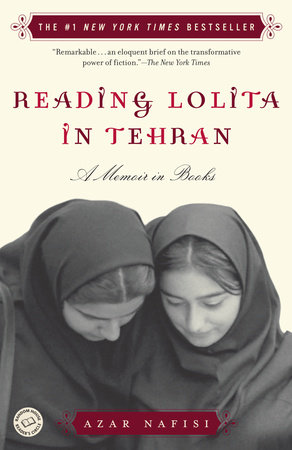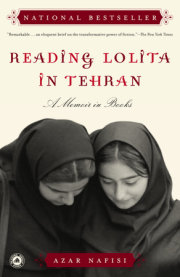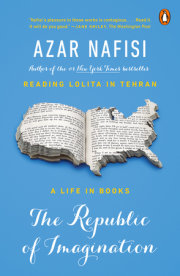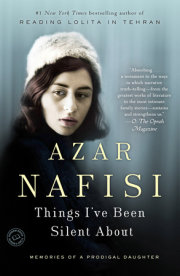Chapter 1In the fall of 1995, after resigning from my last academic post, I decided to indulge myself and fulfill a dream. I chose seven of my best and most committed students and invited them to come to my home every Thursday morning to discuss literature. They were all women-to teach a mixed class in the privacy of my home was too risky, even if we were discussing harmless works of fiction. One persistent male student, although barred from our class, insisted on his rights. So he, Nima, read the assigned material, and on special days he would come to my house to talk about the books we were reading.
I often teasingly reminded my students of Muriel Spark's The Prime of Miss Jean Brodie and asked, Which one of you will finally betray me? For I am a pessimist by nature and I was sure at least one would turn against me. Nassrin once responded mischievously, You yourself told us that in the final analysis we are our own betrayers, playing Judas to our own Christ. Manna pointed out that I was no Miss Brodie, and they, well, they were what they were. She reminded me of a warning I was fond of repeating: do not, under any circumstances, belittle a work of fiction by trying to turn it into a carbon copy of real life; what we search for in fiction is not so much reality but the epiphany of truth. Yet I suppose that if I were to go against my own recommendation and choose a work of fiction that would most resonate with our lives in the Islamic Republic of Iran, it would not be The Prime of Miss Jean Brodie or even 1984 but perhaps Nabokov's Invitation to a Beheading or better yet, Lolita.
A couple of years after we had begun our Thursday-morning seminars, on the last night I was in Tehran, a few friends and students came to say good-bye and to help me pack. When we had deprived the house of all its items, when the objects had vanished and the colors had faded into eight gray suitcases, like errant genies evaporating into their bottles, my students and I stood against the bare white wall of the dining room and took two photographs.
I have the two photographs in front of me now. In the first there are seven women, standing against a white wall. They are, according to the law of the land, dressed in black robes and head scarves, covered except for the oval of their faces and their hands. In the second photograph the same group, in the same position, stands against the same wall. Only they have taken off their coverings. Splashes of color separate one from the next. Each has become distinct through the color and style of her clothes, the color and the length of her hair; not even the two who are still wearing their head scarves look the same.
The one to the far right in the second photograph is our poet, Manna, in a white T-shirt and jeans. She made poetry out of things most people cast aside. The photograph does not reflect the peculiar opacity of Manna's dark eyes, a testament to her withdrawn and private nature.
Next to Manna is Mahshid, whose long black scarf clashes with her delicate features and retreating smile. Mahshid was good at many things, but she had a certain daintiness about her and we took to calling her "my lady." Nassrin used to say that more than defining Mahshid, we had managed to add another dimension to the word lady. Mahshid is very sensitive. She's like porcelain, Yassi once told me, easy to crack. That's why she appears fragile to those who don't know her too well; but woe to whoever offends her. As for me, Yassi continued good-naturedly, I'm like good old plastic; I won't crack no matter what you do with me.
Yassi was the youngest in our group. She is the one in yellow, bending forward and bursting with laughter. We used to teasingly call her our comedian. Yassi was shy by nature, but certain things excited her and made her lose her inhibitions. She had a tone of voice that gently mocked and questioned not just others but herself as well.
I am the one in brown, standing next to Yassi, with one arm around her shoulders. Directly behind me stands Azin, my tallest student, with her long blond hair and a pink T-shirt. She is laughing like the rest of us. Azin's smiles never looked like smiles; they appeared more like preludes to an irrepressible and nervous hilarity. She beamed in that peculiar fashion even when she was describing her latest trouble with her husband. Always outrageous and outspoken, Azin relished the shock value of her actions and comments, and often clashed with Mahshid and Manna. We nicknamed her the wild one.
On my other side is Mitra, who was perhaps the calmest among us. Like the pastel colors of her paintings, she seemed to recede and fade into a paler register. Her beauty was saved from predictability by a pair of miraculous dimples, which she could and did use to manipulate many an unsuspecting victim into bending to her will.
Sanaz, who, pressured by family and society, vacillated between her desire for independence and her need for approval, is holding on to Mitra's arm. We are all laughing. And Nima, Manna's husband and my one true literary critic-if only he had had the perseverance to finish the brilliant essays he started to write-is our invisible partner, the photographer.
There was one more: Nassrin. She is not in the photographs-she didn't make it to the end. Yet my tale would be incomplete without those who could not or did not remain with us. Their absences persist, like an acute pain that seems to have no physical source. This is Tehran for me: its absences were more real than its presences.
When I see Nassrin in my mind's eye, she's slightly out of focus, blurred, somehow distant. I've combed through the photographs my students took with me over the years and Nassrin is in many of them, but always hidden behind something-a person, a tree. In one, I am standing with eight of my students in the small garden facing our faculty building, the scene of so many farewell photographs over the years. In the background stands a sheltering willow tree. We are laughing, and in one corner, from behind the tallest student, Nassrin peers out, like an imp intruding roguishly on a scene it was not invited to. In another I can barely make out her face in the small V space behind two other girls' shoulders. In this one she looks absentminded; she is frowning, as if unaware that she is being photographed.
How can I describe Nassrin? I once called her the Cheshire cat, appearing and disappearing at unexpected turns in my academic life. The truth is I can't describe her: she was her own definition. One can only say that Nassrin was Nassrin.
For nearly two years, almost every Thursday morning, rain or shine, they came to my house, and almost every time, I could not get over the shock of seeing them shed their mandatory veils and robes and burst into color. When my students came into that room, they took off more than their scarves and robes. Gradually, each one gained an outline and a shape, becoming her own inimitable self. Our world in that living room with its window framing my beloved Elburz Mountains became our sanctuary, our self-contained universe, mocking the reality of black-scarved, timid faces in the city that sprawled below.
The theme of the class was the relation between fiction and reality. We read Persian classical literature, such as the tales of our own lady of fiction, Scheherazade, from A Thousand and One Nights, along with Western classics-Pride and Prejudice, Madame Bovary, Daisy Miller, The Dean's December and, yes, Lolita. As I write the title of each book, memories whirl in with the wind to disturb the quiet of this fall day in another room in another country.
Here and now in that other world that cropped up so many times in our discussions, I sit and reimagine myself and my students, my girls as I came to call them, reading Lolita in a deceptively sunny room in Tehran. But to steal the words from Humbert, the poet/criminal of Lolita, I need you, the reader, to imagine us, for we won't really exist if you don't. Against the tyranny of time and politics, imagine us the way we sometimes didn't dare to imagine ourselves: in our most private and secret moments, in the most extraordinarily ordinary instances of life, listening to music, falling in love, walking down the shady streets or reading Lolita in Tehran. And then imagine us again with all this confiscated, driven underground, taken away from us.
If I write about Nabokov today, it is to celebrate our reading of Nabokov in Tehran, against all odds. Of all his novels I choose the one I taught last, and the one that is connected to so many memories. It is of Lolita that I want to write, but right now there is no way I can write about that novel without also writing about Tehran. This, then, is the story of Lolita in Tehran, how Lolita gave a different color to Tehran and how Tehran helped redefine Nabokov's novel, turning it into this Lolita, our Lolita.
2
And so it happened that one Thursday in early September we gathered in my living room for our first meeting. Here they come, one more time. First I hear the bell, a pause, and the closing of the street door. Then I hear footsteps coming up the winding staircase and past my mother's apartment. As I move towards the front door, I register a piece of sky through the side window. Each girl, as soon as she reaches the door, takes off her robe and scarf, sometimes shaking her head from side to side. She pauses before entering the room. Only there is no room, just the teasing void of memory.
More than any other place in our home, the living room was symbolic of my nomadic and borrowed life. Vagrant pieces of furniture from different times and places were thrown together, partly out of financial necessity, and partly because of my eclectic taste. Oddly, these incongruous ingredients created a symmetry that the other, more deliberately furnished rooms in the apartment lacked.
My mother would go crazy each time she saw the paintings leaning against the wall and the vases of flowers on the floor and the curtainless windows, which I refused to dress until I was finally reminded that this was an Islamic country and windows needed to be dressed. I don't know if you really belong to me, she would lament. Didn't I raise you to be orderly and organized? Her tone was serious, but she had repeated the same complaint for so many years that by now it was an almost tender ritual. Azi-that was my nickname-Azi, she would say, you are a grown-up lady now; act like one. Yet there was something in her tone that kept me young and fragile and obstinate, and still, when in memory I hear her voice, I know I never lived up to her expectations. I never did become the lady she tried to will me into being.
That room, which I never paid much attention to at that time, has gained a different status in my mind's eye now that it has become the precious object of memory. It was a spacious room, sparsely furnished and decorated. At one corner was the fireplace, a fanciful creation of my husband, Bijan. There was a love seat against one wall, over which I had thrown a lace cover, my mother's gift from long ago. A pale peach couch faced the window, accompanied by two matching chairs and a big square glass-topped iron table.
My place was always in the chair with its back to the window, which opened onto a wide cul-de-sac called Azar. Opposite the window was the former American Hospital, once small and exclusive, now a noisy, overcrowded medical facility for wounded and disabled veterans of the war. On "weekends"-Thursdays and Fridays in Iran-
the small street was crowded with hospital visitors who came as if for a picnic, with sandwiches and children. The neighbor's front yard, his pride and joy, was the main victim of their assaults, especially in summer, when they helped themselves to his beloved roses. We could hear the sound of children shouting, crying and laughing, and, mingled in, their mothers' voices, also shouting, calling out their children's names and threatening them with punishments. Sometimes a child or two would ring our doorbell and run away, repeating their perilous exercise at intervals.
From our second-story apartment-my mother occupied the first floor, and my brother's apartment, on the third floor, was often empty, since he had left for England-we could see the upper branches of a generous tree and, in the distance, over the buildings, the Elburz Mountains. The street, the hospital and its visitors were censored out of sight. We felt their presence only through the disembodied noises emanating from below.
I could not see my favorite mountains from where I sat, but opposite my chair, on the far wall of the dining room, was an antique oval mirror, a gift from my father, and in its reflection, I could see the mountains capped with snow, even in summer, and watch the trees change color. That censored view intensified my impression that the noise came not from the street below but from some far-off place, a place whose persistent hum was our only link to the world we refused, for those few hours, to acknowledge.
That room, for all of us, became a place of transgression. What a wonderland it was! Sitting around the large coffee table covered with bouquets of flowers, we moved in and out of the novels we read. Looking back, I am amazed at how much we learned without even noticing it. We were, to borrow from Nabokov, to experience how the ordinary pebble of ordinary life could be transformed into a jewel through the magic eye of fiction.
Copyright © 2003 by Azar Nafisi. All rights reserved. No part of this excerpt may be reproduced or reprinted without permission in writing from the publisher.









